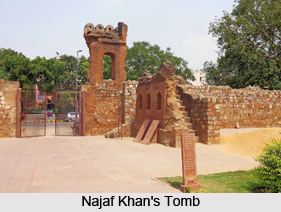 Najaf Khan`s Tomb is located in the city of Delhi opposite Safdarjung Airport which was earlier known as Willingdon Airport. It is situated towards the eastern side of the Delhi Mehrauli Road and in close proximity to Safdarjung`s Tomb. The tomb is now in complete ruined state.
Najaf Khan`s Tomb is located in the city of Delhi opposite Safdarjung Airport which was earlier known as Willingdon Airport. It is situated towards the eastern side of the Delhi Mehrauli Road and in close proximity to Safdarjung`s Tomb. The tomb is now in complete ruined state.
Mirza Najaf Khan
Mirza Najaf Khan was a Safavi prince and a Persian adventurer in the court of Mughal emperor Shah Alam II. He hailed from a royal lineage. His sister was married into the family of the Nawabs of Awadh. He came to India with his sister to join the royal court of Muhammad Shah (1759-1806 A.D.). He also served the rulers of the Mughal Dynasty as the Deputy Wazir of Awadh. Mirza Najaf Khan also served as the commander in chief of the Mughal army from 1772 to 1782 A.D. when he died. It is regarded as one of his most notable contribution in the history of India. He was also instrumental in importing models from the European armies into the Mughal Army that proved to be very beneficial for the Mughal army men. He emphasized and implemented immensely on the principles of order and administration. Mirza Najaf Khan was a man of high principles and served his nation with determination, courage and valour by employing the best of his qualities. It is said that, in 1781 the army of Mirza Najaf Khan was the most formidable military force in India second only to that of the British army in Bengal.
Architecture of Najaf Khan`s Tomb
Najaf Khan`s Tomb has been built in memory of Najaf Khan. The tomb is built in the center of the Mughal charbagh styled garden. The charbagh garden has an enclosure wall. All the four sides of the garden had entrances. Presently the gateway on the eastern side is used as the main entrance. The mausoleum stands on a raised platform made of red sandstone. The most interesting part of the tomb is that it has been constructed as a structure without a dome. Thus, from a distance looks like a plinth with two cenotaphs on top of it. One of the cenotaphs belongs to Najaf Khan and the other to his daughter Fatima who died in 1820. The plinth or the base is arched and is adorned with chambers on it. The cenotaphs can be reached from a double sided staircase built on the eastern side. The real graves are in one of the two chambers in the heart of the platform.



















